We can’t read minds and wishful thinking, biased by personal views just might not cut it when it comes to building a decent product.
In order to put out something valuable we need to provide a solution to a problem. Human beings make decisions based on emotions rather than reason. Knowing as much as possible about the problems that actually make them grind their teeth is huge.
What?
Questions to discover pain points:
- What is your biggest problem regarding the given topic?
- What are your top 3 challenges you face in this matter?
- What gives you the biggest headache about this?
- What keeps you awake at night in connection with X?
Prioritizing the problems:
- What do you spend the most time on? What do you spend the most money on?
- What is important to you regarding the topic?
- What are you the most proud of in connection to the topic?
- What is the most exciting, interesting thing regarding the topic?
- Is there anything you are afraid of regarding the topic?
Questions to help find a solution:
- When exactly did the given problem appear for the last time? Where were you? With whom?
- Please tell us in detail about the last actual example when the problem appeared. How did it happen?
- How do you deal with the problem now? How much money/time/resources does the current solution take?
What not to ask:
- Would you use it ?
- Do you like it?
- Do you need it ?
- Would you pay for it? How much?
People are not aware enough of their needs to provide valuable answers to these questions.
It’s easy to claim that they will buy and use it in an interview or questionnaire environment. We aim to please and keep the peace so we’ll tell you what we think you want to hear to make you happy and create the means for a positive encounter.
Who ?
We could just start asking questions to just about anybody. But we’re not aiming to help and please everybody. That’s why, creating a suitable setting for a relaxed, yet focused chat can happen is the ground level. The main purpose of interviews is to find and prioritize the problems that the users face.
5-6 interviews would offer enough insights to get you started. If your product connects or services several segments of users, consider 5 for each segment.
You will need follow up interviews to clarify details and get more input. Make sure you ask for permission to get back in touch.
Bonus: you can consider using at least a part of them to test the product.
How?
Interviewing might seem like an easy thing to do: you just ask the questions, note down the answers and move on. But it’s hard to convince people to talk to you in the first place, let alone offer you details abut what makes them angry, ashamed or just frustrated. Would you share your vulnerabilities to a total stranger?
Many pretend they don’t have problems at all. Some are unaware that have problems. I usually start with a personal conversation where I introduce myself and the goal of the project, but withholding details that could lead to a biased interviewee. If they understand what we’re trying to build, they might be open to help. People skills are paramount to pulling this off, and going in head first to ask the sensitive questions will fail to open the door to valuable insights.
Listen carefully to what they share with you, connect with their deep problems, validate and mirror what you understand and try to identify when they tell you what they think you want to hear and bring up the socially accepted answers. Going through the questions you have planned like a robot will not yield the key results you are after. Explore the matters deeper using questions like:
- What else?
- Could you tell me more about that?
- It that the only thing that happened?
The more relaxed they will be, the close you will get to the core issues. The more relaxed you will be, the quicker you will be able to connect with them and step behind the curtain. Having an audio recorder or somebody to take notes helps a lot with that. It could also add a degree of anxiety to your interviewee. No pressure.
Here’s a flow to get you started:
- Greet the user
- Introduce yourself and the purpose of the interview
- Ask questions to qualify the user
- Questions flow
- Thank for the help
- Ask for permission to contact further
- Say good-bye



